Le Lancia Delta "integrali"
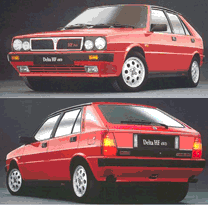
In 1986, May, at the restyling of the Lancia Delta, the Delta HF 4WD is presented.
Designed for the use of common days and only at a later time basis for a rally, the Delta HF 4WD is characterized by details that set it apart from the Delta "normal" and that accentuate the sporting character as the circular light, alloy wheels, dual exhaust and the two profiles in contrast with the body color running along the side.
The engine of the Delta HF 4WD is a 2-liter engine similar to that of the Thema turbo ie, able to develop a power of 165 hp at 5250 rev / min.

Also interesting is the traction schema used for the Delta HF 4WD: front differential, center differential with viscous coupling locking Ferguson that distributes torque asymmetrically on the two axes (56% front and 44% rear), Torsen differential at rear.
The overboost, acts on the wastegate valve every time you press hard on the gas, temporarily increasing the boost pressure: in this way, the motor comes to expressing a torque equal to 285 Nm (29 kgm ) at only 2500 rpm/min.
The chassis has no substantial differences with respect to the standard front-wheel drive versions.
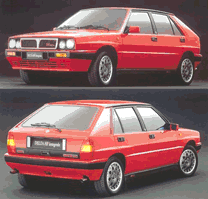
In 1987, November, Lancia launched the first evolution of the Delta four-wheel drive: the Delta HF Integrale.
It features a new version of the engine of 1995 cm3, with a whole series of changes:
A new larger Garrett T3 turbocharger allows an increase of the air flow and a better perform.
A new calibration of the overboost, increases the boost pressure to 1 bar and maximum torque of 31 kgm.
The electronic engine management system is recalibrated.
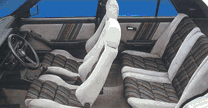
For the Delta HF Integrale valves, valve seats, gaskets and water pump are adapted to higher performance, as well as water and oil radiators;
the fan is more powerful and the air filter has a greater capacity.
The power is increased to 185 hp at 5300 rpm and peak torque to 304 Nm (31 kgm) at 3500 rpm.
The new clutch is the same as the Thema Ferrari 8.32 and suspension have new front springs and new shocks, hubs, drive shafts, couplings: the attitude is more sporty and suited to the new dimensions of wheels (6J x 15" with glossy exterior and interior painted in gray) and tires (195/55 VR 15).
On the outside, the bumper has a new design and wrap the widened wheel arches.
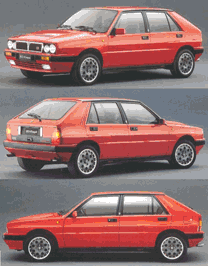
Production model of the Delta is now linked to the development of the car for racing:
And so, while the HF Integrale is still winning, in May 1989, is presented to the public the new Delta HF Integrale 16V.
The engine now has 4 valves per cylinder.
The power increases to 200 hp.
A new turbocharger and the remapping of the ECU IAW injection/ignition, enhances torque, which is moved for the first time to the rear axle.
The distribution is now 47/53% thus reducing the understeer.
The braking system is enhanced, as well as the suspension; the clutch has an hydraulic control.
The design of the Delta HF Integrale 16V is more aggressive thanks to larger tires and a new engine cover, which features new air-intake grilles and a central bulge of about 3 cm, which is necessary in order to accommodate the new engine 16 valves.
Performances are outstanding: 220 km/h maximum speed, 26.1 seconds to travel a kilometer from a standing start and 5.7 seconds to accelerate from 0 to 100 km/h.
To meet the first anti-pollution requirements, is also produced a version called
Delta Integrale HF Kat, with 8v engine equipped with a catalytic converter.
This version, "provides" only 177 hp. Externally it has the same features as the 16v version and is recognizable only by the different "label".
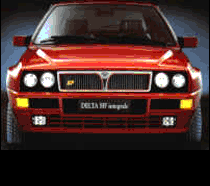
October 1991: the new Delta HF Integrale comes on the market.
Commonly called "Evoluzione" or "Deltona" is the ultimate expression of a continuous growth of technological innovations accompanied by countless statements sports.
On an aesthetic level, this new version comes with some changes dictated by the need to increase the tracks and turning up the attacks of the shock absorbers.
Then we find a new bonnet with a more pronounced bulge with new grilles and air side and wheel arch extensions even more pronounced.
The lights of the Delta HF Integrale Evolution are completely new, with dual headlights reduced in diameter to 130 mm, but with an improved intensity and light distribution.
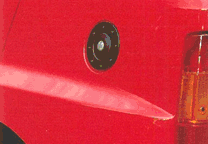
Additional air intakes improve the cooling of the engine compartment.
The fuel filler neck is as used in competitions.
The windshield wipers have a different design that improves the efficiency at high speeds and on top of the tailgate a spoiler is added, which improves the drag coefficient of the car.
The exhaust system provides a single pipe with terminal 60mm diameter.
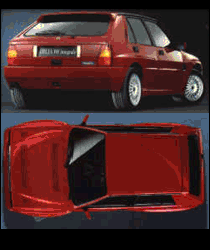
The power of the engine of the Delta HF Integrale Evoluzione is now 210 hp at 5750 rpm.
The steering pump now delivers efficiency with values ??close to the one used for competitions.
On the power steering is added a cooling coil.
The max speed is now of 220 km/h and the Deltona takes 5.7 seconds to accelerate from 0 to 100.
Is introduced as option, for the first time, the air conditioner.
To meet the anti-pollution requirements, also of the Deltona is produced a Kat version.
This version, "provides" 186 hp.
In 1992, with the closure of Chivasso Plant, ends production of the Delta HF Integrale Evoluzione.
From 1993 to 1995 Maggiora, who took over the original Lancia Plant, built for Lancia a further latest version, commonly called EVO2.
The 16v engine is "upgraded", adding the catalyst, finally becoming Euro1.
Thanks to targeted interventions, power increase and reaches 215 hp at 5750 rpm while torque grows to 32 kgm at just 2500 rpm.
It is fitted with a small turbo and changes to the ECU Magneti-Marelli.
The engine becomes more elastic, with less turbo lag, but it is not "bad" as the previous versions.
It's the first Lancia Delta, starting from HF4WD, to be designed specifically for the sale and not for racing.
Aesthetically (and functional) you can see 16" wheels, with tires 205/45 ZR, new roof and gutters, seats in beige Alcantara, a new Momo steering wheel.
Standard with ABS and Air Conditioning.



